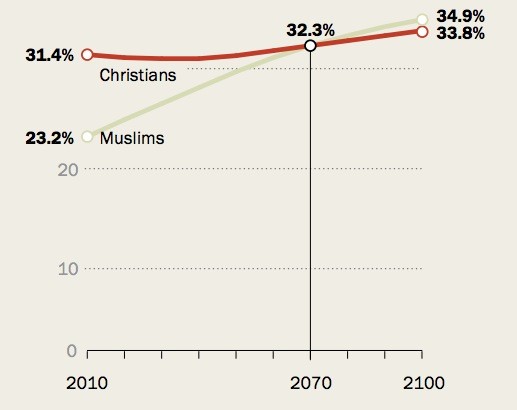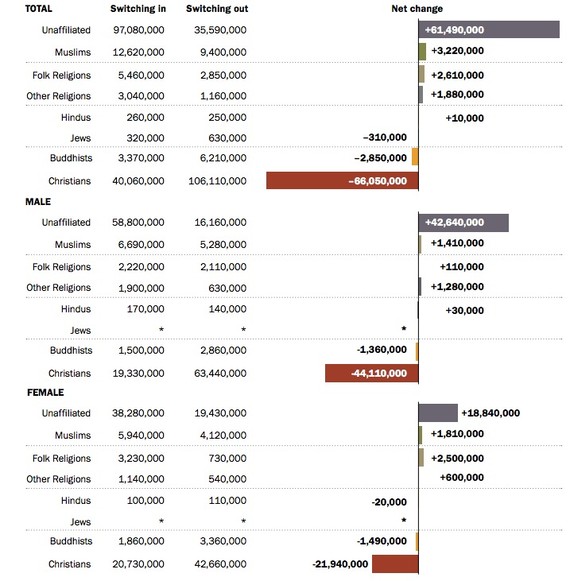Who can predict what the world will look like in 55 years? If there's one group willing to go boldly forth into the statistical unknown, it's demographers. Armed with regressions, piles of data, and many a chart, the researchers at Pew have projected that after 2070, the world's Muslims will outnumber the world's Christians.
"In the process of gathering all the data to think about the future of religion in the world, we learn about differences between religious groups that exist today," said Conrad Hackett, the lead demographer on the massive new report. Researchers looked at census data, surveys, and population registers for 234 countries to estimate the future sizes of the world's religious groups. They advise readers to interpret the data with caution—there's a page-long section called "disclaimers"—but offer insight into what demographers know best: how births, deaths, and migration define peoples over time.
The results are fascinating. The Muslim population, for example, is expected to grow twice as fast as the rest of the world's population between now and 2050, largely because Muslims tend to be young and have high fertility rates. A majority of Muslims will still live in Asia and the Pacific region, as they do now (even though Islam is the predominant religion of the Middle East, only one in five Muslims live there). While their life expectancy will likely rise over the next four decades, on average, Muslims will still die younger than members of any other religion, including folk religions. Jews, on the other hand, will live the longest; in 2050, the group's life expectancy will be 85, compared with 75 for Muslims. This is partly because the Jewish population is so concentrated, Hackett said: Roughly 80 percent of Jews live in Israel or the United States, both highly developed countries.
But perhaps the most significant finding is that Muslims may gradually overtake Christians as the world's largest religious group in the coming decades.
Projected Christian and Muslim Shares of the Global Population, 2010-2100

Consider the situation in Europe, where Christianity has historically been dominant. Now, it's the only region where the absolute number of Christians is expected to decline in the coming years. In 2010, 75 percent of Europe's population was Christian; by 2050, that percentage is expected to be closer to 65. In general, the continent's total population is expected to shrink.
Europe's population of Muslims, however, is expected to get much larger, growing by 28 million people over four decades. Muslims will still be a minority in the region, accounting for roughly 10 percent of Europe's population by 2050. But given that Islam's growing presence has already contributed to significant social and political conflict across the continent, this change could be consequential.
In Europe and beyond, age, fertility rates, and migration are the most important factors in projected population changes, but religious conversion also plays a minor role in the results. Despite Christianity's tradition of evangelism, the faith is expected to lose a net total of about 66 million people around the world due to conversions, accounting for both those who convert into the faith and those who convert out. A significant portion of those converts will likely become unaffiliated, a group that's expected to grow by a net total of roughly 61 million purely due to people leaving their religions (as opposed to via higher birth rates, etc.).
As the graph below shows, the majority of those who leave Christianity will be men; they're expected to account for roughly 60 percent of those who choose to leave the religion. Hackett said this is partially explained by the fact that women tend to have higher levels of religious commitment than men. It's also worth noting that this gender difference in patterns of conversion holds for Christianity but not Islam: In certain Muslim countries, Hackett said, there's little religious switching in general, partly because of the serious social and legal consequences people might face for a change of faith.
Projected Changes in the World's Religious Populations Due to Conversion, 2010-2050

The data seems to undermine the theory that the world is on an inevitable, historical march toward secularization. The number of people who don't claim any particular religion is expected to rise modestly in the next few decades, but the world is going to grow much faster than the religiously unaffiliated population will. Most non-religious people live in China, Japan, and the United States, with significant numbers in Europe as well—all places with relatively old populations and low birth rates. Forty years from now, the non-religious portion of the world's population will still only be about 13 percent, which is slightly less than what it was in 2010.
The world is on track to become more homogeneously religious, not more secular.
One open question is how religiosity will play out in China. Right now, there isn't a lot of reliable data about religious affiliation in the world's most populous country, Hackett said. Most population information comes from the government, which has been more or less hostile toward organized religion since the late 1960s; even if the country's citizens are religious, they might be unlikely to share their beliefs on a government questionnaire, he said. One scholar, the Purdue University professor Fenggang Yang, says the country is becoming more faithful, though. He estimates that the percentage of Christians in China could grow from 5 percent in 2010 to 67 percent in 2050, based on the growth rate of the religion over time; if this came true, it would significantly shift the world's total Christian population.For both Christianity and Islam, the region with the most potential will be sub-Saharan Africa, where the population is expected to double in roughly four decades due to extremely high fertility rates. The number of Christians in the region is also expected to double, reaching over 1.1. billion people, and the Muslim population is projected to grow by an astounding 170 percent, hitting nearly 670 million. Largely because of these trends, researchers estimate that two-thirds of the world's population will be Christian or Muslim by 2100.
The world is on track to become a more homogeneously religious place, not a more diverse and secular one. Theories of secularization are based on a vision of a world culturally dominated by the West, and it's true that the United States and Europe may become somewhat less religious in the coming years. But in terms of sheer numbers, the West is shrinking, and the rest of the world is on a very different path: one that's headed toward God.
No comments:
Post a Comment